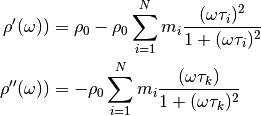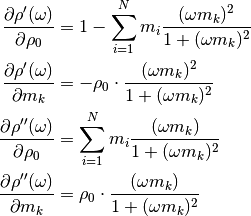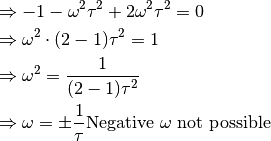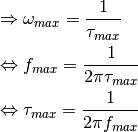Debye decomposition resistivities¶
complex¶
![\hat{\rho}(\omega) &= \rho_0 \left(1 - \sum_{i=1}^{N} m_k \left[1 -
\frac{1}{1 + i \omega \tau_i}\right] \right)\\](_images/math/6a6e0e411dcc55eaad4c695288a64f2e4a417514.png)
real and imaginary parts¶

Derivatives¶

Relating peak frequency of imaginary part to relaxation time¶
Notes:

Determine the frequency maximum of the negative of the imaginary part using the first derivation:
![Im(\hat{\rho}(\omega)) &= - \rho_0 \sum_{i=1}^N m_i \frac{(\omega
\tau_k)}{1 + (\omega \tau_k)^2}\\
\frac{\partial Im}{\partial \omega} &= \frac{\partial \omega (-\rho_0 m
\omega \tau) [1 + (\omega \tau)^2] - (-\rho_0 m \omega \tau)
\partial \omega (1 + (\omega \tau)^2)}{[1 + (\omega \tau)^2]^2}\\](_images/math/7a6cdeff2542fc7242b7f6dcac81fd73692ea063.png)
![&= \frac{(-\rho_0 m \tau) [1 + (\omega \tau)^2] + \rho_0 m \omega \tau
\cdot 2 \omega \tau \tau}{[1 + (\omega \tau)^2]^2}\\
\Rightarrow \frac{\partial -Im}{\partial \omega} &= 0\\
&\Leftrightarrow - \rho_0 m \tau - \rho_0 m \tau (\omega \tau)^2 + 2
\omega^2 \tau^3 m \rho_0 = 0\\
& / \tau / \rho_0 / m\\](_images/math/adcec3d8c0eaeb454ea0f5905ef2d37305d5cc04.png)


Peak relaxation times¶
Peak relaxation times for the conductivity (a.k.a. Cole-Cole, CC) and the resistivity (a.k.a. Pelton, P) formulation are related by:

The relation hold for both the Cole-Cole model and the Debye model (c=1).
Additionally, they also hold for the decomposition approach, here the
chargeability has to be replaced by the total chargeability:  .
.